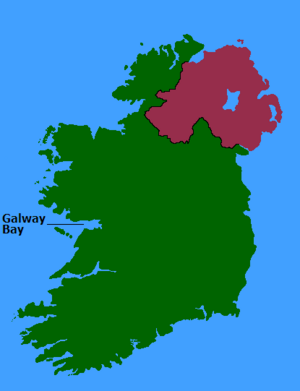Galway Bay facts for kids
Galway Bay is a large bay on the west coast of Ireland. In Irish, it's called Loch Lurgain or Cuan na Gaillimhe. This beautiful bay sits between County Galway to the north and County Clare to the south.
The city of Galway is found on the northeast side of the bay. Galway Bay is about 50 kilometers (31 miles) long. It is also quite wide, ranging from 10 kilometers (6.2 miles) to 30 kilometers (19 miles) across.
At the western entrance of the bay are the Aran Islands. Many smaller islands are also found inside the bay. The rocks to the west of Galway are granite. However, to the south, the rocks are limestone.
The bay has several main entrances between the Aran Islands and the mainland:
- The North Sound (An Súnda ó Thuaidh) is between Inishmore and Leitir Mealláin.
- Gregory's Sound (Súnda Ghríoghóra) is between Inishmore and Inishmaan.
- Foul Sound (An Súnda Salach) is between Inishmaan and Inisheer.
- The South Sound (An Súnda ó Theas) is between Inisheer and County Clare.
Galway Bay is well-known for its special traditional sailing boats. These boats are called Galway hookers.
A Special Place for Nature
The coastal areas of Galway Bay are very important for nature. They have been named a Special Area of Conservation. This means the area is protected because it has many important natural places.
These places include mud and sandflats, coastal lagoons, and saltmarshes. There are also unique temporary lakes called turloughs. You can also find vegetated cliffs and limestone pavements.
Galway Bay is home to many animals. Common seals and otters live here. It is also a key spot for many kinds of birds. These include seabirds, wading birds, and waterfowl.
The lagoons in the bay have slightly salty water. They are home to many different plants. These include special water plants like tasselweed. There are also unique algae that only grow in lagoons.
Some areas have tall great fen-sedge and black bog-rush. Other plants like common reed and purple moor-grass also grow here.
One turlough at Ballinacourty becomes a temporary lake in winter. It covers about 25 hectares (62 acres). Plants like amphibious bistort and marsh bedstraw grow near its exit hole.
You can find grasslands rich in orchids on some low hills west of Galway City. These areas have plants that like calcium. Examples include kidney vetch and spring gentian. Beautiful orchids like the common spotted-orchid also grow here.
The saltmarshes have interesting features. Besides plants like thrift and lax-flowered sea lavender, you can also see small brown seaweeds growing among the plants.
Remembering a Sad Event
On May 4, 1902, a sad event happened on Galway Bay. Eight fishermen from a nearby village lost their lives. They were sailing near Kilcolgan. Seven of them drowned. One fisherman, Patrick Walsh, swam to shore but sadly died from exhaustion.
After this tragedy, people raised money to help the families of the fishermen. A memorial was later placed in the Claddagh area of Galway to remember them.
Gallery
-
Galway Bay from Salthill.
See also
 In Spanish: Bahía de Galway para niños
In Spanish: Bahía de Galway para niños







